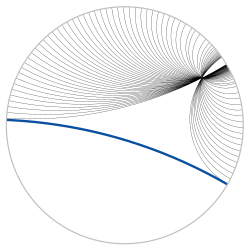Poincaré disk model

Imagine you are playing with a big ball, like a beach ball or a basketball. You can bounce the ball up and down, throw it to someone else, roll it on the ground, and spin it around. But have you ever thought about how the ball actually looks from different angles?
One way to think about the ball is to picture it as a flat surface, like a table. But this can be tricky, because the ball is actually round, not flat. So, people use different models to help them understand how the ball looks from different points of view.
One model that mathematicians use is called the Poincaré disk model. In this model, the ball is seen as a circle on a flat surface. But there's a catch - the circle is distorted, like a funhouse mirror. Instead of being a perfect round shape, the circle is squeezed in towards the middle of the disk.
To understand why the circle looks distorted, imagine that you have a sheet of paper and a round cookie cutter. If you cut out a circle from the center of the paper, the edges of the circle will stay the same distance from the center of the paper. But if you cut out a circle from the edge of the paper, the edges of the circle will be closer to the center of the paper than the middle of the circle. That's what's happening in the Poincaré disk model - the circle is closer to the center of the disk than it is at the edges.
Now, using this model, mathematicians can do some pretty cool things. They can explore shapes and patterns on the circle, and figure out how they would look if the circle was rolled or twisted. They can also use the model to study other things in math, like geometry and topology.
So, to sum it up - the Poincaré disk model is a way of looking at a ball as a flat surface, like a circle on a disk. This helps mathematicians study different shapes and patterns in a unique way.
One way to think about the ball is to picture it as a flat surface, like a table. But this can be tricky, because the ball is actually round, not flat. So, people use different models to help them understand how the ball looks from different points of view.
One model that mathematicians use is called the Poincaré disk model. In this model, the ball is seen as a circle on a flat surface. But there's a catch - the circle is distorted, like a funhouse mirror. Instead of being a perfect round shape, the circle is squeezed in towards the middle of the disk.
To understand why the circle looks distorted, imagine that you have a sheet of paper and a round cookie cutter. If you cut out a circle from the center of the paper, the edges of the circle will stay the same distance from the center of the paper. But if you cut out a circle from the edge of the paper, the edges of the circle will be closer to the center of the paper than the middle of the circle. That's what's happening in the Poincaré disk model - the circle is closer to the center of the disk than it is at the edges.
Now, using this model, mathematicians can do some pretty cool things. They can explore shapes and patterns on the circle, and figure out how they would look if the circle was rolled or twisted. They can also use the model to study other things in math, like geometry and topology.
So, to sum it up - the Poincaré disk model is a way of looking at a ball as a flat surface, like a circle on a disk. This helps mathematicians study different shapes and patterns in a unique way.
Related topics others have asked about:
